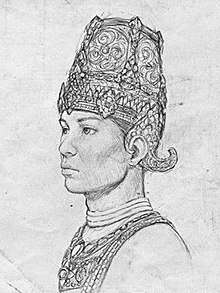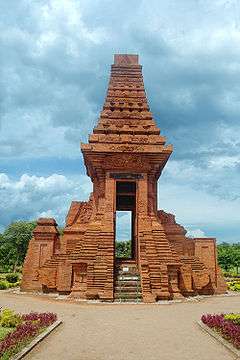Jayanegara
Jayanegara or Jayanagara (formal regnal name Sri Maharaja Wiralandagopala Sri Sundarapandya Dewa Adhiswara, or Sri Sundarapandyadevadhisvara Vikramottungadeva, also known as Kala Gemet), Prince of Kediri in 1295,[1]:201,233 reigned from 1309 to 1328, was a Javanese King and the second monarch of Majapahit empire. Jayanegara was the heir, crown prince, the son of Raden Wijaya, the founder of Majapahit. The story of his life was written in several records, including Pararaton and Negarakertagama. His reign saw the beginning of Gajah Mada's rise as an important figure in the empire.
| Sri Maharaja Wiralandagopala Sri Sundarapandya Dewa Adhiswara | |||||
|---|---|---|---|---|---|
 Illustration of Jayanagara | |||||
| King of Majapahit | |||||
| Reign | 1309 - 1328 | ||||
| Predecessor | Raden Wijaya | ||||
| Successor | Tribhuwana Wijayatunggadewi | ||||
| Died | 1328 Majapahit Empire | ||||
| Burial | Kapopongan Palace, Antawulan (Trowulan) | ||||
| |||||
| Dynasty | Rajasa dynasty | ||||
| Father | Raden Wijaya | ||||
| Mother | Dara Petak | ||||
| Religion | Hinduism | ||||
Early life
Raden Wijaya took all of Kertanegara's four daughters' hands in marriage. The siblings were Tribhuwaneswari the oldest also the queen, Prajnaparamitha, Narendra Duhita, and Gayatri Rajapatni the youngest. The reasons of Raden Wijaya's practice of sibling polygamy was to ensure his claim of legitimacy, also to prevent the contest for Kertanegara's Singhasari legacy. Raden Wijaya also took Indreswari (also known as Dara Petak), the princess of Malayu Dharmasraya Kingdom whom brought to Majapahit court from Sumatra through Kertanegara's Pamalayu expedition. Raden Wijaya or Prince Nararya Sangramawijaya ascended to the Majapahit throne as King Kertarajasa Jayawardhana.
Jayanegara was King Kertarajasa's son, his name in Sanskrit-derived Old Javanese words: jaya ("glorious") and nagara ("city" or "nation"), which means "glorious nation". Without a doubt, Prince Jayanegara was a legitimate son of Raden Wijaya. However, there are several versions concerning Jayanegara's mother. Some earlier historians consider him as the son of Queen Tribhuwaneswari (not to be confused with Tribhuwana Wijayatunggadewi, Jayanegara's half-sister daughter of Gayatri Rajapatni), thus earning him the right to become the crown prince. However, according to Pararaton, Jayanegara was Wijaya's son from Dara Petak, princess of Malayu Dharmasraya. While Queen Tribhuwaneswari and most of her sisters were childless, only Gayatri Rajapatni had two daughters; Tribhuwana Wijayatunggadewi and Rajadewi. To reconcile these facts, some historians suggested that Jayanegara was Dara Petak's son adopted by childless Queen Tribhuwaneswari and raised as her own.
Reign
The reign of Jayanegara was a difficult and chaotic one, as was his father's, marked with several rebellions by former companions in arms. Among others are Gajah Biru's rebellion in 1314 and the Kuti rebellion in 1319. The Kuti rebellion was the most dangerous rebellion and a significant one, as Kuti managed to take control of palace and the capital city. With the help of Gajah Mada and his palace guard,[1]:233 Jayanegara barely escaped from the capital and safely hid in Badander village. While the king was in hiding, Gajah Mada returned to the capital city to learn the situation. After learning that Kuti's rebellion was not supported by the people or the nobles of Majapahit court, Gajah Mada led the resistance forces to crush the Kuti rebellion.
Finally, the Kuti forces were crushed and Jayanegara safely returned to his throne. For his loyalty and excellent service, Gajah Mada was promoted to higher office and began his career in court royal politics.[2]
According to tradition, although strikingly handsome, Jayanegara was notorious for his immorality and bad behavior. He was known for his unpopular acts of desiring the wives and daughters of his subordinates. For this, he was entitled Kala Gemet, or "weak villain".
One of his distasteful acts was his desire to take his own stepsisters, Tribhuwana Wijayatunggadewi and Rajadewi, as wives. He put his half-sisters in the custody of a fortified palace and left them unmarried beyond their suitable age for marriage. However, his act was likely motivated to ensure his position and legitimacy, to prevent the future contest from the suitors of his half-sisters.
His unpopularity in Javanese literature and traditions was fuelled by his origin as the son of a Sumatran Malayu princess, thus making him viewed as a foreigner, not a true Javanese. He also was not the son of any of Kertanegara's daughters, thus making him weak in his legitimacy on Rajasa dynastic legacy.
He sent embassies to China from 1325 to 1328.[1]:234

Assassination
In 1328, Jayanegara was murdered by his doctor, Tanca, during a minor operation. Gajah Mada punished and killed Tanca right away before the thorough investigation commenced. The true nature of Jayanegara's assassination has remained a mystery.
George Coedes states he was "assassinated by a noble whose wife he had seduced."[1]:234 Some historians concluded that the afformentioned Tanca was this nobleman.
Another theory suspects that Gajah Mada was the mastermind behind the assassination, as Gajah Mada was the loyal and trusted advisor for Princess Tribhuwana Wijayatunggadewi. Jayanegara remained childless until his death without an heir, and his throne was passed to one of his siblings.
Rajapatni Gayatri, first wife of Raden Wijaya, was supposed to secure the throne since Jayanegara had no sons. However, she became a bhikkhuni, so her daughter, Tribhuvana (Tribhuwana Wijayatunggadewi, or Tribhuwannottungadewi Jayawishnuwardhani), became the regent. By 1330, she had married Chakradhara, or Chakresvara, who assumed the title of Prince of Singhasari and the name Kritavardhana. Their son, Hayam Wuruk, was born in 1334 and became king in 1350.[1]:234
The Bajang Ratu gate in Trowulan was traditionally linked to Jayanegara. The gate was identified as the part of Çrenggapura (Çri Ranggapura), his pedharmaan, the Kapopongan of Antawulan, a holy compound to appease and honor the soul of the late King Jayanegara.
References
- Cœdès, George (1968). The Indianized states of Southeast Asia. University of Hawaii Press. ISBN 9780824803681.
- Ya'cob Billiocta (22 April 2015). "Misteri pemberontakan Ra Kuti hingga wajah asli sang Gajah Mada". Merdeka.com (in Indonesian).
- Slamet Muljana. 2005. Menuju Puncak Kemegahan. Jakarta: LKIS
- Slamet Muljana. 1979. Nagarakretagama dan Tafsir sejarahnya. Jakarta: Bhratara
| Preceded by Raden Wijaya |
Monarch of Majapahit Empire 1309–1328 |
Succeeded by Tribhuwana Wijayatunggadewi |